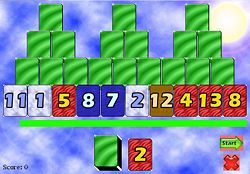Difference between revisions of "Math4Team/RIT/Projects/Fun Towers"
Cdaniels29 (talk | contribs) |
Cdaniels29 (talk | contribs) |
||
| Line 52: | Line 52: | ||
* Squeak by Example (http://www.iam.unibe.ch/~scg/SBE/SBE.pdf) | * Squeak by Example (http://www.iam.unibe.ch/~scg/SBE/SBE.pdf) | ||
* Squeak Download (http://www.squeak.org/Download/) | * Squeak Download (http://www.squeak.org/Download/) | ||
| + | * SoapCore Squeak SOAP client (http://map.squeak.org/package/dab9b621-00d2-41c3-966c-458bf62b8008) | ||
==Project Setup== | ==Project Setup== | ||
Revision as of 10:45, 1 May 2009
Group Members
Project Description
Fun Towers is a pre-existing game that can be found online in several version (http://www.funnytowers.com/ is one example) that has been ported to the XO, written in Squeak. Our team is modifying this purely numerical/card based game into one that can be used as a teaching tool as part of the 4th grade math project.
Our initial goals in modifying the pre-existing game remain relatively simple and achievable, and our goal is to produce verifiable results that can be used to point to the very preliminary success of the math4 program, while more in-depth projects are still in development.
The game itself is simple, users are given a card and with it are able to remove from one of 3 pyramids of cards a card that is one greater or one lower in value. This card that has been removed is the users new card, and any cards that were covered by the removed card are now in play.
Proposed Domains
- 4.N.4: Select, use, and explain models to relate common fractions and mixed numbers (1/2, 1/3, 1/4, 1/5, 1/6, 1/8, 1/10, 1/12, and 11/2), find equivalent fractions, mixed numbers, and decimals, and order fractions.
- 4.N.1: Exhibit an understanding of the base ten number system by reading, modeling, writing, and interpreting whole numbers to at least 100,000; demonstrating an understanding of the values of the digits; and comparin and ordering the numbers.
- 4.N.2: Represent, order, and compare large numbers (to at least 100,000) using various forms, including expanded notation, e.g., 853 = 8 x 100 + 5 x 10 + 3.
- 4.N.5: Identify and generate equivalent forms of common decimals and fractions less than one whole (halves, quarters, fifths, and tenths).
- 4.N.11: Know multiplication facts through 12 x 12 and related division facts. Use these facts to solve related multiplication problems and compute related problems, e.g., 3 x 5 is related to 30 x 50, 300 x 5, and 30 x 500.
- 4.N.16: Round whole numbers through 100,000 to the nearest 10, 100, 1000, 10,000, and 100,000.
- 4.N.18: Use concrete objects and visual models to add and subtract common fractions.
- 4.P.1: Create, describe, extend, and explain symbolic (geometric) and numeric patterns, including multiplication patterns like 3, 30, 300, 3000, ….
- 4.P.3: Determine values of variables in simple equations, e.g., 4106 – x = 37, 5 = y + 3, and s – y = 3.
- 4.M.2: Carry out simple unit conversions within a system of measurement, e.g., hours to minutes, cents to dollars, yards to feet or inches, etc.
Initial Proposed Modifications
- Remove Timer: Though most versions of the Fun Towers game include some sort of timer, it would not be as applicable in an educational version of the game.
- Change card graphics: The game currently only supports cards which are integers from 1~13, new cards will need to be created which represent the elements of the mathematical series which we plan to implement.
- Implement level select: The player will need a way to chose which type of mathematical series they work with.
Possible Future Modifications
- Multi-player support: Allow players to work together to take down the towers, potentially allowing students of different skill levels to work together, by having each student working with a different topic.
- Description of tasks to be performed per level, localized.
- Integrate teacher reporting API (potentially using SoapCore)
Project Resources
- Fun Towers XO Game Download (http://www.hpi.uni-potsdam.de/hirschfeld/projects/olpc/media/Funtowers_080601.xo)
- Fun Towers Game Source (http://www.hpi.uni-potsdam.de/hirschfeld/projects/olpc/media/Funtowers_OLPC_080121.sar)
- Squeak by Example (http://www.iam.unibe.ch/~scg/SBE/SBE.pdf)
- Squeak Download (http://www.squeak.org/Download/)
- SoapCore Squeak SOAP client (http://map.squeak.org/package/dab9b621-00d2-41c3-966c-458bf62b8008)
Project Setup
Download from the squeak download page both the squeak executable for your operating system as well as the squeak image file. Download the Fun Towers game source. Run the squeak executable with the image in the same directory to open squeak. Drag the fun towers .sar file onto the squeak environment to load the game into squeak. Left click in the squeak environment to bring up the main menu and click 'new morph', go to from alphabetical list, D-F, and click on FtGame. The game is now loaded in the squeak environment.
Updates
4/17 - Initial project start, creation of wiki page, general planning.
4/24 - Updated Wiki page, removed timer loss from game source, implemented rudimentary deck increase (prevents losing)
4/28 - Worked on updating card graphics
4/29 - Second attempt at deck increase in squeak code, could not a better version then the initial. Initial attempts at adding a level select. Initial prototypes for 4th grade math topic cards produced
Weekly Schedule
Week 6:
- Develop Schedule - Complete
- Game Prototype - Complete
Week 7:
- Finalize 4th grade math domains for levels - Complete
- Begin learning/working with code from open source fun towers game - Complete
Week 8:
- Produce modified cards for additional levels - Prototypes Complete
- Initial integration of 4th grade math topics
Week 9:
- Implement in-game level selector
- Implement level transition
Week 10:
- Potential API integration
- General Polish
Contacts
Math4 mod team
- Eric Mallon (EricMallon@gmail.com)
- Tyler Bragdon (eldrac@gmail.com)
- Chris Daniels (chris.m.daniels@gmail.com)
Original authors: Thomas Beyhl, Johannes Dyck, Robert Gurol, Maximilian Jenders, Johannes Köhler, Matthias Richly, and Marcus Wacke at http://www.hpi.uni-potsdam.de/swa/
